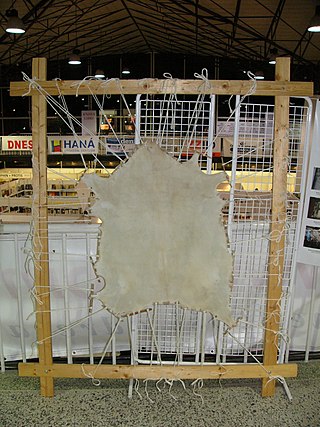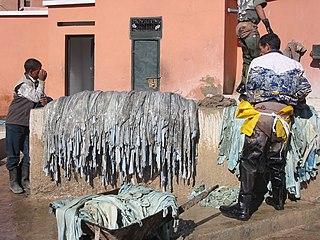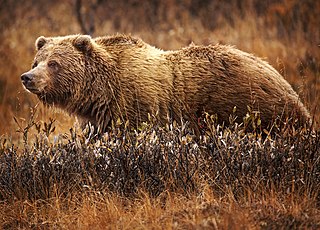
Leather is a strong, flexible and durable material obtained from the tanning, or chemical treatment, of animal skins and hides to prevent decay. The most common leathers come from cattle, sheep, goats, equine animals, buffalo, pigs and hogs, and aquatic animals such as seals and alligators.

Parchment is a writing material made from specially prepared untanned skins of animals—primarily sheep, calves, and goats. It has been used as a writing medium for over two millennia. Vellum is a finer quality parchment made from the skins of young animals such as lambs and young calves.

Vellum is prepared animal skin or membrane, typically used as writing material. It is often distinguished from parchment, either by being made from calfskin, or simply by being of a higher quality. Vellum is prepared for writing and printing on single pages, scrolls, and codices (books).

Tanning, or hide tanning, is the process of treating skins and hides of animals to produce leather. A tannery is the place where the skins are processed.

Suede is a type of leather with a fuzzy, napped finish, commonly used for jackets, shoes, fabrics, purses, furniture, and other items. The term comes from the French gants de Suède, which literally means "gloves from Sweden". The term was first used by The Oxford English Dictionary in 1884.
Rawhide is a hide or animal skin that has not been exposed to tanning. It is similar to parchment, much lighter in color than leather made by traditional vegetable tanning.

Buckskin is the soft, pliable, porous preserved hide of an animal – usually deer – tanned in the same way as deerskin clothing worn by Native Americans. Some leather sold as "buckskin" may now be sheepskin tanned with modern chromate tanning chemicals and dyed to resemble real buckskin.

Fur clothing is clothing made from the preserved skins of mammals. Fur is one of the oldest forms of clothing and is thought to have been widely used by people for at least 120,000 years. The term 'fur' is often used to refer to a specific item of clothing such as a coat, wrap, or shawl made from the fur of animals.

Sheepskin is the hide of a sheep, sometimes also called lambskin. Unlike common leather, sheepskin is tanned with the fleece intact, as in a pelt.

The conservation and restoration of parchment constitutes the care and treatment of parchment materials which have cultural and historical significance. Typically undertaken by professional book and document conservators, this process can include preventive measures which protect against future deterioration as well as specific treatments to alleviate changes already caused by agents of deterioration.

Calfskin or calf leather is a leather or membrane produced from the hide of a calf, or juvenile domestic cattle. Calfskin is particularly valuable because of its softness and fine grain, as well as durability. It is commonly used for high-quality clothing, shoes, wallets, and similar products, as well as traditional leather bookbindings. In these contexts, just "calf" is commonly used. Fine calfskin is one of the skins used for vellum and parchment manuscripts.

Fur is a thick growth of hair that covers the skin of almost all mammals. It consists of a combination of oily guard hair on top and thick underfur beneath. The guard hair keeps moisture from reaching the skin; the underfur acts as an insulating blanket that keeps the animal warm.

A leather jacket is a jacket-length coat that is usually worn on top of other apparel or item of clothing, and made from the tanned hide of various animal skins. The leather material is typically dyed black, or various shades of brown, but a wide range of colors is possible. Leather jackets can be designed for many purposes, and specific styles have been associated with subcultures such as greasers, motorcyclists, and bikers, mobsters, military aviators and music subcultures, who have worn the garment for protective or fashionable reasons, and occasionally to create a potentially intimidating appearance.
Humanity has used animal hides since the Paleolithic, for clothing as well as mobile shelters such as tipis and wigwams, and household items. Since ancient times, hides have also been used as a writing medium, in the form of parchment.

Kazakh clothing, worn by the Kazakh people, is often made of materials suited to the region's extreme climate and the people's nomadic lifestyle. It is commonly decorated with elaborate ornaments made from bird beaks, animal horns, hooves and feet. Although contemporary Kazakhs usually wear Western dress, the Turkic people wear more traditional clothing for holidays and special occasions.

Kidskin or kid leather is a type of soft, thin leather that is traditionally used for gloves. It is widely used for other fashion purposes such as footwear and clothing. Kidskin is traditionally made from goatskin - more specifically, the skin of young goats, although equivalent leathers such as lambskin and chickenskin give the same effect.

Crocodile skin either refers to the skin of a live crocodile or a leather made from dead crocodile hide. It has multiple applications across the fashion industry such as use for bags, shoes, and upholstery after being farmed and treated in specialist farms and tanneries.

Leather is created when an animal skin or hide is chemically treated in a process called tanning to preserve them for long term use as material for clothing, handbags, footwear, furniture, sports equipment and tools. Alligator leather is also commonly used to create similar items as mentioned above.

Traditional Inuit clothing is a complex system of cold-weather garments historically made from animal hide and fur, worn by Inuit, a group of culturally related Indigenous peoples inhabiting the Arctic areas of Canada, Greenland, and the United States. The basic outfit consisted of a parka, pants, mittens, inner footwear, and outer boots. The most common sources of hide were caribou, seals, and seabirds, although other animals were used when available. The production of warm, durable clothing was an essential survival skill which was passed down from women to girls, and which could take years to master. Preparation of clothing was an intensive, weeks-long process that occurred on a yearly cycle following established hunting seasons. The creation and use of skin clothing was strongly intertwined with Inuit religious beliefs.

Bating, a technical term used in the tanning industry to denote leather that has been treated with hen or pigeon manure, similar to puering where the leather has been treated with dog excrement, and which treatment, in both cases, was performed on the raw hide prior to tanning in order to render the skins, and the subsequent leather, soft and supple. Today, both practices are obsolete and have been replaced in the tanneries with other natural proteolytic enzymes.



















